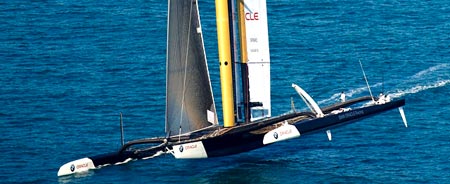
The BMW Oracle team easily won the first America’s Cup race in Valencia, Spain, winning by fifteen minutes over the defender Alinghi.


The BMW Oracle team easily won the first America’s Cup race in Valencia, Spain, winning by fifteen minutes over the defender Alinghi.
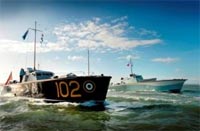 Last Operational World War II Motor Boats Saved For The Nation
Last Operational World War II Motor Boats Saved For The Nation
Two of the last remaining fully operational high-speed World War II motor boats have been saved for the nation today by Portsmouth Naval Base Property Trust, with the help of a £580,000 grant from the National Heritage Memorial Fund (NHMF).
When built, they were among the fastest boats of their type in the world. The boats represented pioneering technology when they were built just down the coast at Hythe near Southampton. They were known as the Spitfires of the Seas and effectively it was like riding on a massive petrol bomb. With 3,000 gallons of fuel on board, if they were hit in the fuel tank they simply exploded. And as they were only made of plywood and had no real armament they were extremely vulnerable.
Read the rest of the article. Thanks to David Hayes for passing along the article.
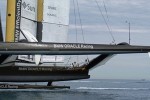 The physics here is fascinating. How is it possible that the America’s Cup challenger ”USA” can sail at 22 knots in only two knots of wind? Chuck Lantz of the Enquirer, explains how it is done.
The physics here is fascinating. How is it possible that the America’s Cup challenger ”USA” can sail at 22 knots in only two knots of wind? Chuck Lantz of the Enquirer, explains how it is done.
America’s Cup boatspeed – Making something out of nothing
Continue reading
 Many ships carrying civilians were sunk during World War II by both sides. If current estimates are correct, the torpedoing of the M/V Wilhelm Gustloff resulted in the largest loss of life from the sinking of one vessel in maritime history. Thanks to Alaric Bond for passing along the article.
Many ships carrying civilians were sunk during World War II by both sides. If current estimates are correct, the torpedoing of the M/V Wilhelm Gustloff resulted in the largest loss of life from the sinking of one vessel in maritime history. Thanks to Alaric Bond for passing along the article.
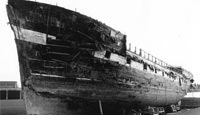 The Scottish Maritime Museum is in dire financial straits. The City of Adelaide, the oldest (just barely) surviving composite clipper ship in the world, has been rotting on a slipway at Irvine, near Glasgow, for almost a decade because the museum lacked the funds to restore her. Now the museum lacks the funds even to pay outstanding dockage fees and to have the old ship broken up. While there has been much talking and pleading to save the ship, so far no one has come up with funding to do so. As we noted in a previous post, while the City of Adelaide, Australia claims that it lacks the funds the enact a rescue, the city did recently spend $30 million to build an enclosure for two pandas on loan from China.
The Scottish Maritime Museum is in dire financial straits. The City of Adelaide, the oldest (just barely) surviving composite clipper ship in the world, has been rotting on a slipway at Irvine, near Glasgow, for almost a decade because the museum lacked the funds to restore her. Now the museum lacks the funds even to pay outstanding dockage fees and to have the old ship broken up. While there has been much talking and pleading to save the ship, so far no one has come up with funding to do so. As we noted in a previous post, while the City of Adelaide, Australia claims that it lacks the funds the enact a rescue, the city did recently spend $30 million to build an enclosure for two pandas on loan from China.
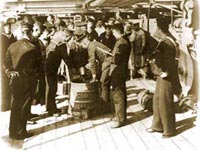
Up Spirit ceremony on HMS Endymion, 1905
Thanks to David Hayes for passing this along. There is something slightly frightening about sailors on a nuclear submarine receiving daily rum rations.
Royal Navy Rum – issued daily to sailors 1655 to 1970
Alcohol and the Royal Navy often seem to go together – there are the nautical phrases for the time in the evening when a drink is OK, “the sun’s over the yardarm”, and having one too many can lead to a person being described as “three sheets to the wind”. And, of course, there’s the old sea shanty, “What Shall We Do With the Drunken Sailor?”
Continue reading
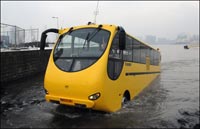 This September, we posted about the popular and nearly ubiquitous “duck tours” using refurbished World War II DUKW amphibious trucks, or vehicles inspired by them, to take tourists on tours in cities and resorts around the world. (See From DUKWs to Ducks, Ducks and More Ducks.) Now an English bus company is testing an “amfibus,” a Dutch amphibious bus, as a possible replacement for a ferry service across the Clyde River, which is scheduled to be shut down this March. After fixing a technical glitch, testing has resumed and everything looks just ducky. (Sorry.)
This September, we posted about the popular and nearly ubiquitous “duck tours” using refurbished World War II DUKW amphibious trucks, or vehicles inspired by them, to take tourists on tours in cities and resorts around the world. (See From DUKWs to Ducks, Ducks and More Ducks.) Now an English bus company is testing an “amfibus,” a Dutch amphibious bus, as a possible replacement for a ferry service across the Clyde River, which is scheduled to be shut down this March. After fixing a technical glitch, testing has resumed and everything looks just ducky. (Sorry.)
A follow-up to our previous post – Free Aircraft Carrier – ex USS John F Kennedy.
Maine group in running for decommissioned JFK
A nonprofit group in Maine says it’s still in the running to bring the decommissioned carrier John F. Kennedy to Portland Harbor as a floating museum.
The USS John F. Kennedy Museum said Wednesday that the Navy has invited it to enter into the next phase to land the 1,052-foot aircraft carrier. According to the group, the Navy said only two organizations made it to the next stage, but didn’t reveal the other group.
Continue reading
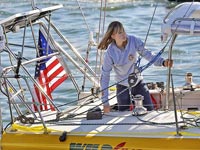 Abby Sunderland is putting into Cabo San Lucas, Mexico, interrupting her round the world attempt, because of a power problem aboard her yacht, Wild Eyes. The yacht’s solar panels and wind generators were not providing enough power and the yacht will be fitted with additional battery capacity.
Abby Sunderland is putting into Cabo San Lucas, Mexico, interrupting her round the world attempt, because of a power problem aboard her yacht, Wild Eyes. The yacht’s solar panels and wind generators were not providing enough power and the yacht will be fitted with additional battery capacity.
 A review by Steven Toby, written for the Maritime History Listserv, included here with his kind permission. Sounds like a fascinating book.
A review by Steven Toby, written for the Maritime History Listserv, included here with his kind permission. Sounds like a fascinating book.
Skipjack: The Story of America’s Last Sailing Oystermen by Christopher White is an excellent book on the last commercial fishing craft operating under sail in the US. The author has a journalistic rather than a scholarly approach, although he has an academic background in the biology/ecology area. He’s a great storyteller, and some of the anecdotes are almost novel-like.
Continue reading
![]() In January we posted about the Jewel of Muscat a replica of a 9th-century sailing ship modelled on a famous Tang Treasure ship. Recently Nova broadcast a documentary on far older ships from the region, Pharaoh Hatshepsut’s ships, dating from 1479 BCE. Pharaoh Hatshepsut was the only female pharoah and she is said to have launched a fabled expedition on great trading ships to a far-away land known as Punt. The expedition is recorded in bas relief on her funeral temple. A team of archeologists and Egyptian boat builders have built a replica of one of these ships and sailed it in the open waters of the Red Sea. It is a fascinating documentary. Click here to read more – Building Pharoah’s Ship, or here to watch the video on-line.
In January we posted about the Jewel of Muscat a replica of a 9th-century sailing ship modelled on a famous Tang Treasure ship. Recently Nova broadcast a documentary on far older ships from the region, Pharaoh Hatshepsut’s ships, dating from 1479 BCE. Pharaoh Hatshepsut was the only female pharoah and she is said to have launched a fabled expedition on great trading ships to a far-away land known as Punt. The expedition is recorded in bas relief on her funeral temple. A team of archeologists and Egyptian boat builders have built a replica of one of these ships and sailed it in the open waters of the Red Sea. It is a fascinating documentary. Click here to read more – Building Pharoah’s Ship, or here to watch the video on-line.
Thank to Bowsprite for pointing out the documentary to us.
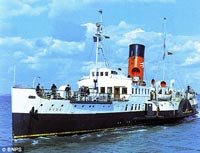 Not every historic vessel can be saved and not every historic vessel should be saved. The difficult question is deciding which are worthy of saving before they fall prey to the ravages of time or, in this case, the bureaucracy. A story from today’s Daily Mail:
Not every historic vessel can be saved and not every historic vessel should be saved. The difficult question is deciding which are worthy of saving before they fall prey to the ravages of time or, in this case, the bureaucracy. A story from today’s Daily Mail:
Mine-sweeper ship that defied the Germans on D-Day set to be scrapped for health and safety reasons
Continue reading
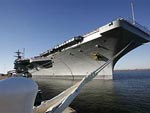 After being under construction for almost a decade, the aircraft carrier George H. W. Bush was accepted by the US Navy following final seatrials last Friday.
After being under construction for almost a decade, the aircraft carrier George H. W. Bush was accepted by the US Navy following final seatrials last Friday.
Northrop Grumman delivers Bush aircraft carrier to Navy
Continue reading

Zac & Abby Sunderland, Jessica Waston & Mike Perham
In July of last year, Zac Sunderland, a 17-year-old from Southern California, became the youngest person to sail around the world alone. He held that tile for only about a month as the British 17 year old sailor, Mike Perham, who was a few months younger than Zac, completed his circumnavigation. Both Zac and Mike made at least one stop along the way around the globe.
Continue reading
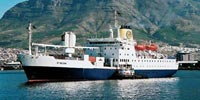 Delivery service for the remote island of St Helena
Delivery service for the remote island of St Helena
The tiny British colony of St Helena in the South Atlantic – the world’s most remote inhabited island – is being hit by Whitehall’s spending cuts. An airport considered by many to be vital for the island’s future has been cancelled.
The Royal Mail Ship St Helena currently delivers all sorts of supplies to the community. Second officer Mia Henry gave BBC News a tour of the ship’s bridge and cargo hold. Click here to view the video.
Continue reading
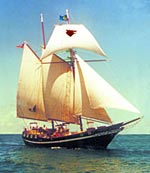 A great story from the Yachtpals blog. Organized by the non-profit group Oceans Watch, a flotilla of at least a dozen yachts loaded with aid for Haiti, led by the 74 foot schooner Wolf, will set sail from Key West on February 8th. A second flotilla is gathering in Jamaica, and there are more yachts throughout the Caribbean either planning to set sail or already en route.
A great story from the Yachtpals blog. Organized by the non-profit group Oceans Watch, a flotilla of at least a dozen yachts loaded with aid for Haiti, led by the 74 foot schooner Wolf, will set sail from Key West on February 8th. A second flotilla is gathering in Jamaica, and there are more yachts throughout the Caribbean either planning to set sail or already en route.
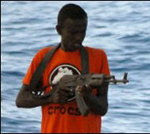 Last week we posted about the International Chamber of Shipping’s concern that governments are not doing enough to combat piracy. Now the British government, after long opposing the payment of ransoms to free hijacked ships is also trying to discourage the use of armed guards on UK merchant ships. British government policy appears to be to not provide adequate naval defenses against piracy, to oppose the shipowner’s use of onboard guards and then to oppose the ship owner’s payment of ransom to free hijacked ships and crews.
Last week we posted about the International Chamber of Shipping’s concern that governments are not doing enough to combat piracy. Now the British government, after long opposing the payment of ransoms to free hijacked ships is also trying to discourage the use of armed guards on UK merchant ships. British government policy appears to be to not provide adequate naval defenses against piracy, to oppose the shipowner’s use of onboard guards and then to oppose the ship owner’s payment of ransom to free hijacked ships and crews.
Continue reading
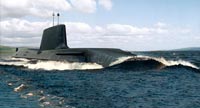 Last week a navy commander and two fellow officers pleaded guilty to crashing the HMS Superb, a British nuclear submarine, in 2008, into a massive stone pinnacle under the Red Sea which was marked on maritime charts.
Last week a navy commander and two fellow officers pleaded guilty to crashing the HMS Superb, a British nuclear submarine, in 2008, into a massive stone pinnacle under the Red Sea which was marked on maritime charts.
Navy commander crashed £32m British submarine after failing to ensure craft’s ’safe direction’
Continue reading
 An Aframax tanker, the Eagle Otome, collided with an oil barge in the Sabine Neches Waterway at Port Arthur, Texas on Saturday. Initial reports suggested 12, 000 barrels of crude oil were unaccounted for, though local officials are now estimating that approximately 1,000 barrels were actually spilled. The crude oil spill is reported to have been contained to a two-mile area and was not believed to have hurt any local wildlife. No injuries were reported but 100 residents were evacuated from the area for about seven hours Saturday morning.
An Aframax tanker, the Eagle Otome, collided with an oil barge in the Sabine Neches Waterway at Port Arthur, Texas on Saturday. Initial reports suggested 12, 000 barrels of crude oil were unaccounted for, though local officials are now estimating that approximately 1,000 barrels were actually spilled. The crude oil spill is reported to have been contained to a two-mile area and was not believed to have hurt any local wildlife. No injuries were reported but 100 residents were evacuated from the area for about seven hours Saturday morning.
Coast Guard: Oil spill in Texas waterway contained
Continue reading